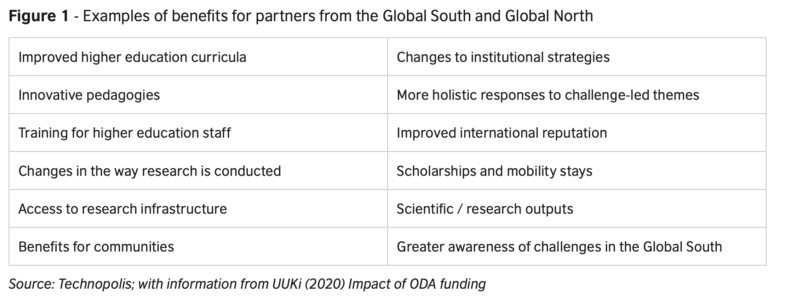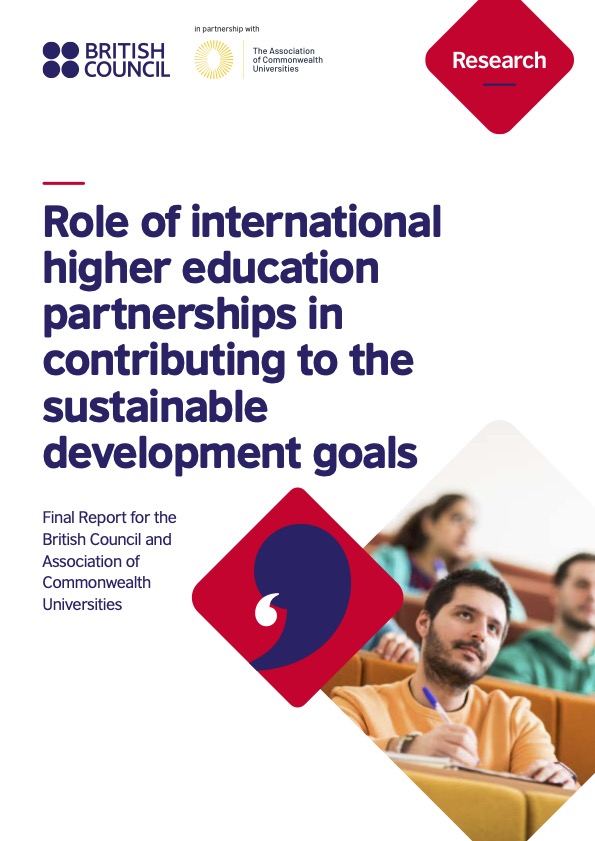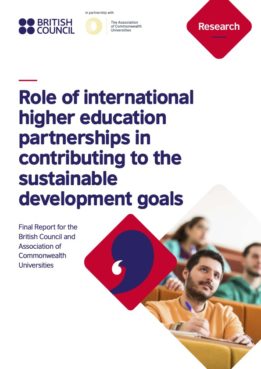Role of international higher education partnerships in contributing to the sustainable development goals
Date de publication : 15 février 2022 | langue de rapport : EN
This study, prepared between March and July 2021, aimed to understand the role of international higher education partnerships in contributing to realising the Sustainable Development Goals (SDGs).
Embeddedness of the Sustainable Development Agenda in the design of international partnerships
There is a complementary relationship between the strategies and plans of international higher education partnerships and the SDGs. The SDGs are rarely explicitly referenced but can be seen within the priorities and objectives. In addition, the SDGs are seen as a useful overarching framework and universally applicable in many contexts and at different levels. Where partnerships do not directly work with the SDGs, they often reference national, regional, and/or local strategies, which in turn are linked directly to the SDGs, e.g. Agenda 2063 for Africa.
It is highly likely that donors’ funding programmes will make direct links to the SDGs more often in the future, and we will, therefore, see more international partnerships referencing the SDGs in the coming years.
Equity among partners and mutual benefits stemming from international partnerships
There is no generally recognised definition of an “equitable partnership” and there are no set criteria for measuring how equitable international higher education partnerships are. Nevertheless, there are several factors that influence the degree of equity among partners. The choice of partners influences equity considerably. Partnerships in which the partners have worked together for a long time engender an environment of mutual trust and understanding, which supports equity. Nevertheless, this makes it more difficult for new players to engage in equitable partnerships.
There are challenges linked to equity, especially for partners in the Global South. Northern higher education institutions are still often seen as more credible with funders by their counterparts in the Global South and, therefore, Northern partners tend to come to partnerships from a stronger negotiation position than Southern partners. The perceived credibility issue is linked to how funding arrangements influence equity. Taking a lead role remains challenging for Southern partners because funders often prefer (and sometimes even require) Northern partners to lead due to accountability and audit rules.
Equity in setting partnership objectives and delivery models is somewhat separate from equity in grant management. There is a growing emphasis on giving a more equitable and prominent role to Southern partners and funders increasingly push for demonstrating the equity in project proposals. Nevertheless, challenges remain, especially due to lack of capacity in some Southern partners. There is still a need for funders to provide more support for capacity building pre application.
There are a number of benefits which derive from international higher education partnerships, both for Northern and Southern partner institutions. The benefits for Southern partners are much better defined and documented than for Northern partners and typical examples include new curricula, innovations in pedagogy and training for academics. The benefits often extend beyond the partnerships, into the community.
Benefits for Northern partners remain less well mapped and understood. This could be partially explained by a lower awareness and exploration of the benefits in the Global North (and for Northern partners) stemming from international higher education partnerships. However, they are possible to synthesise and Figure 1 presents selected examples of the various benefits stemming from partnerships, both for Southern and Northern partners.

There are also risks of unequal benefits, in particular in research partnerships, because Northern partners tend to gain more recognition of the results for academic publication, which then could generate spill over benefits at the institutional level (e.g. evidence for REF submission).
Contribution of international HE partnerships to the SDGs
Overall, the research shows that international higher education partnerships contribute significantly to the UN’s Sustainable Development Agenda and its 17 SDGs. Clear links between partnerships’ activities and outcomes and the SDGs can be found in practically all mapped partnerships. Partnerships are relevant for all 17 SDGs, with SDG4 (quality education) and SDG17 (partnerships for the goals) emerging more strongly than others. The research identified many specific partnership activities and outcomes relevant for each SDG, which were studied in depth in the case studies and aggregated in the report.
The SDGs are also interlinked, reflecting the importance of interdisciplinary approaches to tackle wider societal issues. One SDG cannot be achieved in isolation and International higher education partnerships are better equipped than single organisations, to address societal issues because they bring together various types of partners from various disciplines and various sectors.
Partnerships have two ways in which they perform their function of contributing to the SDGs through their outcomes:
- As contributors to the knowledge base. These are often research partnerships offering practicable solutions but no implementation or scale-up in practice
- As implementors of new knowledge. These are often teaching and learning partnerships conducting research, but also implementing the results in practice (e.g. within their partner organisations)
International higher education partnerships involve organisations working together, typically with external funding (or funding derived from their own sources). There are a number of important drivers identified in the study which can be described as enabling conditions for contribution to the SDGs:
- An environment of mutual trust and open communication among the partners
- A shared vision and long-term commitment to working together
- The engagement of the senior higher education institution (HEI) leadership in the partnership, through endorsement or active participation
- An in-built flexibility in the funders, donors and fund managers
- The existence of national-level quality assessment criteria and international university rankings which assign value to the SDGs
- Good risk management within the partnerships
Furthermore, external funders can exercise considerable power over the funded partnerships, which influences on the partnerships’ contribution to the SDGs. Some of the traditional donors in the Global North are going to put more emphasis in their next programming periods on ensuring that their funded portfolio directly contributes to the SDGs. This will be reflected in funders’ operations through funding application processes, as well as through interim and ex-post monitoring.
The study has also identified challenges to the contribution to the SDGs:
- Covid-19 pandemic (those partnerships set up before the Covid-19 pandemic tend to continue, however new ones may find it more difficult to form due to reduced opportunities to make contacts. We may see fewer new partnerships in the months and years coming unfortunately)
- Complex governance structures at HEIs and resistance to change
- Insufficient capacity to manage international projects at partner institutions
- Volatility of the funding environment and reliance on short-term funding (reliance on short-term project funding poses a significant challenge for many international higher education partnerships, especially for the sustainability of their results. It is important that the partnerships consider diverse opportunities for funding a variety of funding sources.)
Monitoring and measuring the contribution to the SDGs remain a big issue for the international community. The SDG indicators are in place, however, data collection systems need significant improvements across the globe. Some funders have their own monitoring mechanisms but there are generally not harmonised and, therefore, more effort is necessary in this area.
Added value of the partnership model
The evidence provides clear indications that international aid interventions taking the form of an international partnership deliver added value, compared to other forms of international aid provision. It helps mobilise more resources and complement each other’s expertise within the partnership. Furthermore, it provides more opportunities for mutual learning, networking and increasing visibility.
Partnerships also provide a platform for facilitating collaboration between different types of organisations as they bring them together around common and mutual objectives. Working together helps reduce financial and project management risks and also increases the prospects for future funding.
In this respect, the involvement of higher education institutions in international partnerships can be seen as providing an added value in itself. Higher education institutions are able to bring different types of partners (e.g. public sector organisations, NGOs, private companies and others) and work with them on common goals.
Higher education and sustainable development: building on the success of international higher education partnerships
In tackling the societal challenges locally, newly- established partnerships are often not aware of what has already been achieved elsewhere and so they tend to start from the beginning. This brings risks of duplicities and inefficiencies in addressing the SDGs. In this respect, the role of the Donor Harmonisation Group, which is an informal network of European agencies that administer aid programmes in education, can be key to mitigate these risks. Partnership platforms, a relatively recent phenomenon, can serve as another mitigation way as they bring various partnerships together to share knowledge and good practice (e.g. the IAU HESD Cluster and the UN Office for Partnerships).
Higher education institutions involved in successful partnerships are often those that also adopted institutional reforms internally. This is because participation in partnerships help institutions become more open, internationalised and able to integrate the SDGs within their institutions. There exist recent examples of how universities approach the sustainable development agenda internally and how the SDGs can be integrated in institutional strategies and policies. This is perhaps more challenging in the Global South than in the Global North, however partnerships can act as a leverage by engaging public sector, private sector etc around common objectives.
Methodology of the study
The study was built on a mix-method approach. It made use of both primary and secondary data. The collected and reviewed data included academic and grey literature on higher education and international development, as well as on international higher education partnerships. Primary research took a funnel approach, starting with an identification and mapping of the global international higher education partnership landscape, and continuing with a set of in-depth case studies of selected partnerships. Key informant interviews with funders, academics and other stakeholders complemented the primary data.






